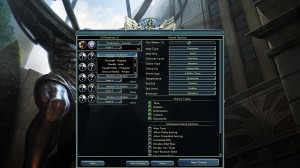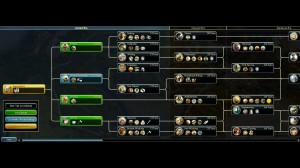“Just one more turn…Just one more turn…I’ve got time for another one…G&% F&*^%*&^ D**%&^%&!!! The sun just came up and I’ve got to leave for work in an hour!”
Turn based games can be both a blessing and a curse. After all of your moves are done, you clearly have a stopping point in which to save and turn the game off should you have more pressing things to do like cleaning, laundry, or killing Orc. Yet, that “End Turn” button mocks us every time we go to turn the game off. That dreaded button softly flashes at us as if to remind us that in three hundred more turns, we can build a nuke and really bring the enemy to their knees.
Those who have played any of the games in the Civilization series know what I’m talking about. For those of you not cool enough to be in the know, Civilization is a game that puts you in charge of a civilization (ironically) which you must advance through the ages while managing diplomacy, combat, economy, and other things. The earlier games were obviously older and not privy to the advancements in video game convenience we have today. When you hit the endgame in Civilization II (1996), you had to manually manage everything from units and workers to cities and build ques. One turn could easily take a half hour, depending on your patience level. As the series lived on, more and more features were added to the games to help alleviate that problem.
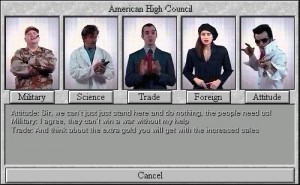
One thing I wish they brought back from Civ II were the advisors that changed appearance as you advanced through the ages. They even went as far as to tell you via full motion video how well you were doing. For the record, the guy doing Elvis wasn’t half bad.
Civilization V is the most recent in the series, bringing convenience to an all time high. It’s very user-friendly and easy to jump into, with or without previous Civ experience. Before you start playing, you’ll be able to pick a civilization, adjust certain game conditions, and adjust the map size to your liking. You’ll also be able to choose how many AI players you will be interacting with and their difficulty level. The difficulty scale will range from pushover easy (Settler) to up yours impossible (Deity).
At first, it may seem like a lot. You’ve got a city surrounded by tiles with all of these icons on it…you’ve got a warrior unit hovering nearby waiting for orders…you may even see a barbarian camp off into the distance if you enabled them in the pregame settings. It’s not too bad really, your main goal will be to keep your city building its available buildings to help it develop and grow in population. A few worker units set on autopilot will move around your area and transform your land into something more valuable which in turn helps your city grow even further. In the meantime you’ll want to keep researching and keep a small military force ready just in case barbarians or other civilizations come knocking. When you’re ready to expand, and you have to in order to survive, you’ll build another settler unit and develop another city a short distance away. You’ll be able to manage its build ques just like your starting city.
As I said…it seems like a lot. Luckily, the game has tool tips to help steer you in the right direction along with the ability to let the computer automatically manage your cities for you. There’s a little more too it than the above…you’ll find out that certain units are stronger on hills or have an attack range greater than one hex (space). You’ll discover city states you can pay to be friends with to gain the benefits of the resources around them…of course, conquering works too, but other civilizations will remember your hostile actions when conducting trade deals and other forms of diplomacy.
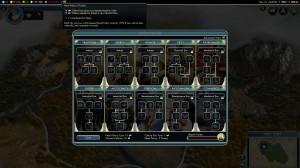
Certain buildings in cities generate culture. Accumulate enough and you can unlock a culture tech in one of the ten talent trees. Some tech trees cannot be unlocked and used with other tech trees, so choose wisely.
Experienced Civilization players will be either relieved or angered to know that Religion was removed from this game. Religion was a big deal and was received with mixed feelings when it was introduced in Civilization IV. I’m also disappointed that Leonard Nimoy will not be reading the famous quote that accompanies the notification that a particular research is complete. Instead we are treated to William Morgan Sheppard who guest starred in various science fiction shows like Star Trek: The Next Generation (The Schizoid Man, Bliss) and Babylon 5. Hands down, Nimoy was better…as if there was any doubt. At any rate, rumor has it that Religion may be making a comeback in a future DLC pack.
Your main objective varies, depending on what victory conditions you set in the pregame. You’ll mainly want to drive to do the same thing no matter which goal you’re shooting for…build your Civilization up faster than the other guy. An enemy who has a slight edge on you in Culture will do little good when he’s defending his cities with musketmen when you’ve got tanks bearing down on him. My recommendation is to play the first few games on the easiest difficulty against one AI opponent, giving you the freedom to build without worrying about a hostile takeover. Practice truly makes perfect.
I won’t go into all of the rules and features in detail…it would take far too long. I will however sum it up by saying that it is a good game. Its features help make a complicated game appeal to both casual and hardcore gamers. There is still a learning curve mind you…if you are one of those people who turn a game on and prefer to just hold in the mouse button down to fire your gun and occasionally strafe to avoid enemy fire then this is not the game for you. Prepare to spend hours on one game alone. The randomized maps and the various pregame options keep the replayability high. If you’re in the mood for a semi-short romp, pick a map that is very small and play only against one or two players. If you have a week off and need something to fill up your time with, create something larger with more AI opponents. You have options.
You’ll also be able to play with or against other people…that is…flesh and blood humans. You can have your friend(s) sit next to you and take turns on the mouse or you can play online. The host has the ability to save the game should anyone need to stop playing…mainly it’s because someone remembered that they haven’t eaten in days.
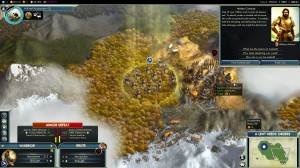
With the new prebattle stat screen (lower left), you’ll be able to tell if the unit you are thinking about sending in to battle will actually win. There’s always random chance, but it is accurate for the most part. Beating up your friends has never been easier.
One thing to note is that you should definitely have a good PC if you intend to try this game. I was able to get it to work eventually on my older Dell XPS machine that used Windows XP / DirectX 9 but it plays much better on my newer laptop. I usually advise checking your PC specs and game requirements at the end of my “gaming” articles but you’ll definitely want to pay attention this time around. One thing to note is that the opening cut scene hides a hidden loading bar, so you will be unable to click past the cut scene until the hidden loading bar is finished. If you click and nothing happens, it’s still loading the game and main menu. When the game is done loading, the cut scene will remember your attempt to skip the cut scene and do so automatically.
There is a playable demo on Steam…you could use that to not only see if you like the game but if your computer can handle it. Now if you’ll excuse me, Gandhi just made fun of my weight…there must be bloodshed.
Final Verdict: 9/10
—


